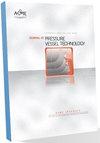Optimization Method for Pneumatic Conveying Parameters and Energy Consumption Performance Analysis of a Compact Blow Tank
IF 1
4区 工程技术
Q4 ENGINEERING, MECHANICAL
Journal of Pressure Vessel Technology-Transactions of the Asme
Pub Date : 2022-07-28
DOI:10.1115/1.4055111
引用次数: 5
Abstract
Pneumatic conveying of powders is a unit process extensively used in industries for the handling of particulate material of several segments. Academic studies started with empirical dilute-phase pneumatic conveying and, in order to produce better economic results in industrial settings, evolved to include energy efficiency techniques as a significant component. Much work has been done to understand and model pneumatic conveying systems; however, they are highly empirical and the conclusions are, in most cases, limited to a narrow range of experimental conditions. This paper introduces a systematic method to select the air pressure and flow necessary to operate an energy-optimized pneumatic conveying system. This method has been tested and applied to a pressure conveyor fed by a compact blow tank of 100 L in a 133 m long pipeline with a diameter of 3 inches conveying limestone. The tests demonstrated that it is possible to control this pneumatic conveying system with only two input parameters, while operating at the desired pressure and airflow and maintaining the respective conveying rate and power requirements.紧凑型鼓风罐气力输送参数优化方法及能耗性能分析
粉末的气力输送是一种在工业中广泛用于处理多个部分的颗粒材料的单元工艺。学术研究始于经验稀相气力输送,为了在工业环境中产生更好的经济效果,逐渐将能效技术作为一个重要组成部分。已经做了大量的工作来理解和建模气力输送系统;然而,它们是高度实证的,在大多数情况下,结论仅限于狭窄的实验条件范围。本文介绍了一种系统的方法来选择运行能量优化的气力输送系统所需的空气压力和流量。该方法已被测试并应用于由直径为3英寸的133米长输送石灰石的管道中的100L紧凑型吹罐供给的压力输送机。测试表明,只需两个输入参数就可以控制该气力输送系统,同时在所需的压力和气流下运行,并保持各自的输送速率和功率要求。
本文章由计算机程序翻译,如有差异,请以英文原文为准。
求助全文
约1分钟内获得全文
求助全文
来源期刊
CiteScore
2.10
自引率
10.00%
发文量
77
审稿时长
4.2 months
期刊介绍:
The Journal of Pressure Vessel Technology is the premier publication for the highest-quality research and interpretive reports on the design, analysis, materials, fabrication, construction, inspection, operation, and failure prevention of pressure vessels, piping, pipelines, power and heating boilers, heat exchangers, reaction vessels, pumps, valves, and other pressure and temperature-bearing components, as well as the nondestructive evaluation of critical components in mechanical engineering applications. Not only does the Journal cover all topics dealing with the design and analysis of pressure vessels, piping, and components, but it also contains discussions of their related codes and standards.
Applicable pressure technology areas of interest include: Dynamic and seismic analysis; Equipment qualification; Fabrication; Welding processes and integrity; Operation of vessels and piping; Fatigue and fracture prediction; Finite and boundary element methods; Fluid-structure interaction; High pressure engineering; Elevated temperature analysis and design; Inelastic analysis; Life extension; Lifeline earthquake engineering; PVP materials and their property databases; NDE; safety and reliability; Verification and qualification of software.

 求助内容:
求助内容: 应助结果提醒方式:
应助结果提醒方式:


